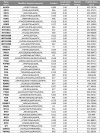Mass spectrometric analysis of lysine ubiquitylation reveals promiscuity at site level
- PMID: 21139048
- PMCID: PMC3047152
- DOI: 10.1074/mcp.M110.003590
Mass spectrometric analysis of lysine ubiquitylation reveals promiscuity at site level
Abstract
The covalent attachment of ubiquitin to proteins regulates numerous processes in eukaryotic cells. Here we report the identification of 753 unique lysine ubiquitylation sites on 471 proteins using higher-energy collisional dissociation on the LTQ Orbitrap Velos. In total 5756 putative ubiquitin substrates were identified. Lysine residues targeted by the ubiquitin-ligase system show no unique sequence feature. Surface accessible lysine residues located in ordered secondary regions, surrounded by smaller and positively charged amino acids are preferred sites of ubiquitylation. Lysine ubiquitylation shows promiscuity at the site level, as evidenced by low evolutionary conservation of ubiquitylation sites across eukaryotic species. Among lysine modifications a significant overlap (20%) between ubiquitylation and acetylation at site level highlights extensive competitive crosstalk among these modifications. This site-specific crosstalk is not prevalent among cell cycle ubiquitylations. Between SUMOylation and ubiquitylation the preferred interaction is through mixed-chain conjugation. Overall these data provide novel insights into the site-specific selection and regulatory function of lysine ubiquitylation.
Figures






References
-
- Yang X. J. (2005) Multisite protein modification and intramolecular signaling. Oncogene 24, 1653–1662 - PubMed
-
- Mann M., Jensen O. N. (2003) Proteomic analysis of post-translational modifications. Nat. Biotechnol. 21, 255–261 - PubMed
-
- Ciechanover A. (1994) The ubiquitin-proteasome proteolytic pathway. Cell 79, 13–21 - PubMed
-
- Scheffner M., Nuber U., Huibregtse J. M. (1995) Protein ubiquitination involving an E1-E2-E3 enzyme ubiquitin thioester cascade. Nature 373, 81–83 - PubMed
-
- Hussain S., Zhang Y., Galardy P. J. (2009) DUBs and cancer: the role of deubiquitinating enzymes as oncogenes, non-oncogenes and tumor suppressors. Cell Cycle 8, 1688–1697 - PubMed
Publication types
MeSH terms
Substances
LinkOut - more resources
Full Text Sources
Other Literature Sources
Molecular Biology Databases

